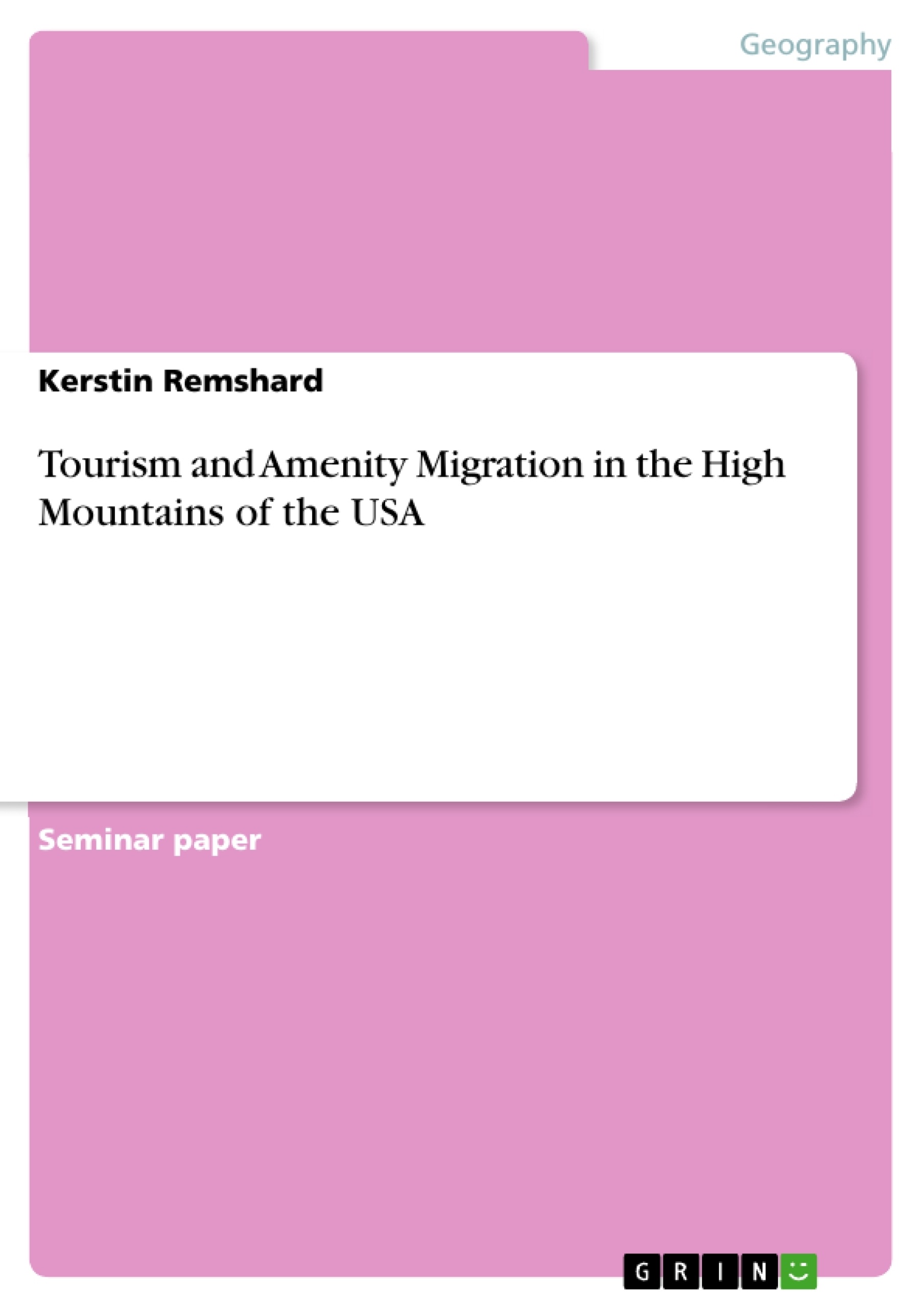Excerpt
Agenda
I. Tourism
1. Historical development
2. Types of High Mountain tourism
3. Skiing tourism
3.1. Finding sustainability in winter sports: Large or small?
3.2. The Colorado ski industry
3.3. Ski resort growth (Example: Whistler, British Columbia)
4. The transformation of mining towns into tourist towns
5. Gambling in the Rocky Mountains
6. Ecological impact of unmanaged OHV-use
II. Amenity migration
1. Definition
2. Characteristics of amenity migrants
3. Reasons for increasing amenity migration
4. Major impacts
References
I. Tourism
1. Historical development
In the nineteenth century visits to the mountains were limited because of a lack of access, poor roads, limited leisure time and low income of the majority of North American citizens (Goeldner, 1996). In the 1860s railroads were built and roads improved, so travel increased slowly, although it was still a privilege of people with high incomes. The number of travellers did a huge jump after World War I as the automobile became affordable for “middle class” families. As the infrastructure improved, more and more summer tourists arrived. A tourism-based economy began to grow, hotels, motels and restaurants were built. Until the skiing movement started in the 50’s and 60’s the winter season was long and uneventful (Goeldner, 1996). When skiing finally became a national trend, major ski resorts developed and many of them were and still are two-season resorts. Central to the tourist group from the mid 60’s on were the baby boomers, ranging in age from 18 to 35 (Goeldner, 1996). As the numbers of tourists were still rising in the 1980’s, locally owned establishments saw themselves competing with big-time operators. Usually a whole complex of lodging, restaurants and everything else to serve the tourists was developed. In the 1990’s mountain tourism has grown to be a powerful economic force. Fast food chains like McDonalds and accommodation chains such as Holiday Inn have come on the scene (Goeldner, 1996). Today in mountain communities outlet stores, gambling, country clubs, exclusive residences etc. can be found. Competition is tougher than ever before and environmental issues challenge the high mountain communities.
2. Types of high mountain tourism
The mountain tourism industry in North America includes a very wide range of activities. Only some examples are cultural tourism, heritage tourism, health tourism, ecotourism, tourism after catastrophic events and an immense range of types of sports tourism.
The popularity of sport-oriented mountain tourism has increased enormously in the last 30 years. Canyoning, hydrospeed, bungee-jumping, carving, hang-gliding, snowboarding or helicopter-skiing are only a few examples for new trend sports. Hunting has also turned into a popular American sport. A major reason for the spread of trend sports is the rapid development and marketing of new technologies by sports companies (Siegrist, 1999). Most participants are younger urban people who are thirsty for action and new experiences. Yet, too often they bring along negative environmental and societal impacts, because they tend to lack that kind of awareness.
3. Skiing tourism
3.1. Finding sustainability in winter sports: Large or small?
In resorts in traditional mountain tourism countries like Austria most companies are small and medium-size. They are usually linked to a co-operative organisation responsible for marketing, information and public services (Bieger, 1999). The North American destinations are generally controlled and managed by just one company. That company is in charge of all major operations, such as the mountain transport system, ski schools, hotels, restaurants etc. Economically, these consolidated resorts may appear more sustainable, because they can adapt more quickly to customer needs. Many of the new North American ski resorts are in areas with no historical local population, what supported such development. Over the years local communities emerged, who are wishing to influence local decision-making and causing social conflicts.
3.2. The Colorado ski industry
Skier visits in Colorado have quite constantly gone up from 192,500 in the 1953/54 season to 12,001,945 in 1997/98. Though Colorado has only 5 percent of the nation’s ski areas it records over 20 percent of the United States skier visits (Goeldner, 1999). What is the reason for that?
As skier visits have grown, so has the number and size of ski resorts. Ski area consolidation was the big change of the 1990s. Research told Colorado ski area managers that there were one or more non-skiers in every skiing party and so activity should be developed for them. The Colorado ski resorts with their innovative marketing programs offer far more than only skiing, meeting the needs of the consumer (Goeldner, 1999). The attractions of a typical North American high mountain tourist area include besides the ski areas national parks and national monuments, state parks, hot springs, historic sites, Indian sites, ghost towns, gold and silver towns and gambling towns.
3.3. Ski resort growth (Example: Whistler, British Columbia)
Whistler ranks around skiers as the number 1 ski destination in North America. It is a planned resort community 120 km north of Vancouver.
[...]
- Quote paper
- Kerstin Remshard (Author), 2005, Tourism and Amenity Migration in the High Mountains of the USA, Munich, GRIN Verlag, https://www.grin.com/document/54855
Publish now - it's free






















Comments